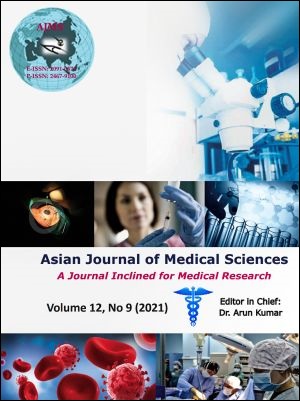Histopathological Study of Endometrium in Patients of Perimenopausal Age Group in a tertiary care Hospital in West Bengal
Keywords:
Endometrial biopsy, Abnormal Uterine Bleeding, Dysfunctional Uterine BleedingAbstract
Background: Menopause is an important event in women’s life and it marks the end of a woman`s reproductive life. Perimenopause is the interval in which a woman`s body makes a natural shift from regular cycles of ovulation & menstruation to irregular cycles and various forms of abnormal uterine bleeding. Dysfunctional uterine bleeding (DUB) is a very frequent complaint from women in the perimenopausal age group. The histological diagnosis of DUB and its proper management is very essential in this age group.
Aims and Objective: Primary aim of our study was to identify the spectrum of histological changes that occur in the endometrium in perimenopausal age group and to identify the demographic pattern of each histological change.
Materials and Methods: Fifty-two specimens of endometrial biopsy obtained from the patients in the perimenopausal age group of 40-50 years attending the Gynaecology and Obstetrics department were studied.
Results: 71.15% cases of DUB was diagnosed amongst the 52 endometrial biopsy specimens in perimenopausal age group and Secretory endometrium is most common histological pattern.
Conclusion: This study reflects a spectrum of endometrial histology present during perimenopausal age. This study has also highlighted the correlation of endometrial histology with final diagnoses of the patients, and this may help in diagnosis and treatment of gynaecological diseases of this specific age group in future.
Downloads
Downloads
Published
How to Cite
Issue
Section
License
Copyright (c) 2021 Asian Journal of Medical Sciences

This work is licensed under a Creative Commons Attribution-NonCommercial 4.0 International License.
Authors who publish with this journal agree to the following terms:
- The journal holds copyright and publishes the work under a Creative Commons CC-BY-NC license that permits use, distribution and reprduction in any medium, provided the original work is properly cited and is not used for commercial purposes. The journal should be recognised as the original publisher of this work.
- Authors are able to enter into separate, additional contractual arrangements for the non-exclusive distribution of the journal's published version of the work (e.g., post it to an institutional repository or publish it in a book), with an acknowledgement of its initial publication in this journal.
- Authors are permitted and encouraged to post their work online (e.g., in institutional repositories or on their website) prior to and during the submission process, as it can lead to productive exchanges, as well as earlier and greater citation of published work (See The Effect of Open Access).




